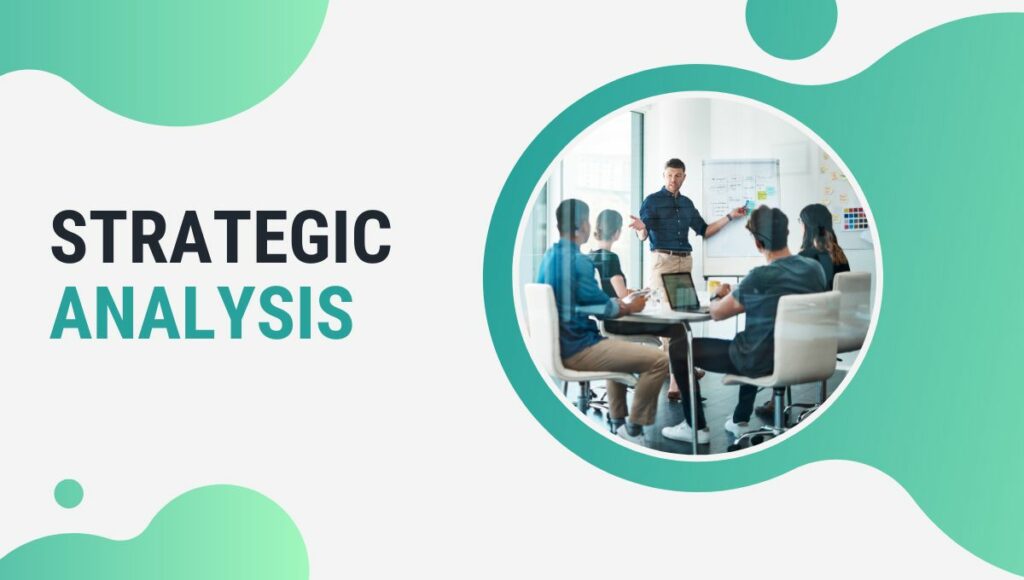Strategic analysis and planning are concepts that are crucial for any business leader or decision-maker. However, planning for your organisation’s future can be difficult without a true analysis of how your company is performing right now and how various environmental challenges in business as well as other industry factors can affect your ability to reach your goals.
This is where strategic analysis plays a crucial role and is lauded as an important tool to gather information and insights that you need to move forward with planning. This business strategy guide will help you understand what strategic analysis means, its framework, and how to conduct strategic analysis.
What is Strategic Analysis?
Strategic analysis is an important process of researching and analysing a company with the business environment in which it operates to formulate an effective strategy. Strategic analysis includes defining the internal and external environments, evaluating identified data, and utilising strategic analysis tools.
By conducting this analysis, businesses get valuable insights into what is working well and what areas need improvement. These crucial insights become key inputs for the strategic planning process, assisting businesses to make well-informed decisions to thrive and grow.
Challenges Affecting Business
Major environmental challenges in business as well as other important factors include:
- Social Factors: Latest social trends, cultural norms, and demographic changes often affect consumer preferences and behaviour.
- Economic Factors: Conditions such as inflation, unemployment rates as well as overall economic growth play an important role in shaping business operations.
- Political Factors: Political factors like government policies, regulations, and political stability can have a profound impact on a business. Moreover, changes in tax laws, trade policies, and regulatory requirements can also affect operations and profitability.
- Environmental Factors: Environmental sustainability and concerns like climate change, resource depletion, and environmental regulations impact business operations and reputation.
- Legal Factors: Compliance with legal requirements, labour laws, and health and safety standards is crucial to avoid legal issues and maintain a positive reputation.
- Technological Factors: Technological advancements and innovations can disrupt industries and create new opportunities.
How to Conduct Strategic Analysis?
The key components of strategic analysis are:
Define the Strategy Level for the Analysis: Before conducting strategic analysis, you need to define where you are in an organisation and your organisation’s size. For example, you might be creating a strategy to guide the direction of an entire company with multiple businesses or just creating a strategy for your marketing team. The three strategy levels are:
- Corporate Strategy
- Business Strategy
- Functional Strategy
Conduct an Internal Analysis: Internal analysis looks inwards at the organisation and assesses the elements that make up the internal environment. This allows you to identify the strengths and weaknesses of your company. The steps involved in this process are:
- Assessment of tools to use. For example, Gap analysis and strategy evaluation are great analysis techniques
- Research and collect information
- Analyse the data and information that is gathered
- Communicate key findings
Conduct an External Analysis: This component looks at an organisation's environment and how these environmental factors currently impact or could impact your organisation. The steps involved in this process are:
- Assessment of tools to use
- Research and collect information
- Analyse information.
- Communicate key findings
Unify Perspectives and Communicate Insights: The process of strategic analysis is a team effort and different team members take responsibility for specific parts, contributing valuable insights, and forming a mosaic of information. This step involves gathering feedback from all team members, collecting all the data, and sharing the complete picture with relevant stakeholders across your organisation.
Strategic Analysis Tools and Methods
The strategic industry analysis framework is based on three major tools and companies use one or more of these tools when conducting strategic analysis. These are:
- SWOT Analysis
SWOT is a simple yet powerful tool to evaluate a company’s:
- Strengths: Internal factors that provide you an advantage over competitors.
- Weakness: Limitations at an internal level that hinder your performance.
- Opportunities: External factors that have growth potential.
- Threats: Threats that are external and can hurt your business.
SWOT analysis provides a clear picture of a company’s current market position and helps identify growth areas.
- PESTLE Analysis
An external strategic analysis type, PESTLE analysis focuses on factors that can impact a company’s success. These may include:
- Political Factors
- Economic Factors
- Legal Factors
- Sociological Factors
- Environmental Factors
- Value Chain Analysis
This strategic planning framework breaks down a business into its core primary and support activities. It looks at business activities and processes that relate to the delivery of your product and service.
Primary activities include:
- Inbound and outbound logistics
- Operations
- Marketing and sales
- After-sales services
Secondary or support activities include:
- Procurement
- Technological development
- Workforce/HR management
- Infrastructure
Strategic Advantage in Dealing with Industry and Environmental Challenges
Strategic analysis helps in giving an organisation a competitive advantage. It equips you with the knowledge to make informed decisions, adapt to market changes, and steer your company towards success. Strategic analysis when implemented in the correct manner ensures that you remain at the forefront of your industry and continue to deliver exceptional value to your clients and customers.
Conclusion
The business world is changing at a rapid rate. Regular strategic analysis can offer an organisation the much-needed edge that enables you to anticipate and respond to various challenges and opportunities. If you want to drive your organisation to success then enrolling in the right senior leadership program can empower and equip you with essential executive leadership skills.
Imarticus Learning brings you the Senior Executive Programme by IIM Nagpur, which will help you learn how to shape your organisation's future with practical business, technology, and operational excellence strategies.









